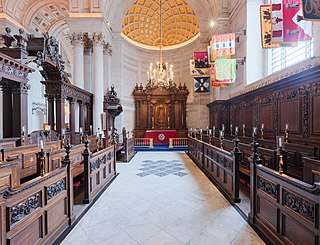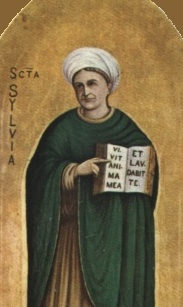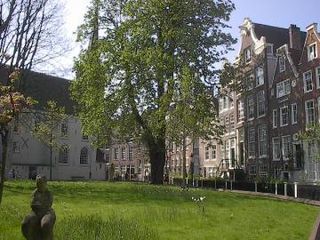| Look up oratory in Wiktionary, the free dictionary. |
Oratory is a type of public speaking.
Contents
Oratory may also refer to:
| Look up oratory in Wiktionary, the free dictionary. |
Oratory is a type of public speaking.
Oratory may also refer to:

A chapel is a Christian place of prayer and worship that is usually relatively small. The term has several meanings. Firstly, smaller spaces inside a church that have their own altar are often called chapels; the Lady chapel is a common type of these. Secondly, a chapel is a place of worship, sometimes non-denominational, that is part of a building or complex with some other main purpose, such as a school, college, hospital, palace or large aristocratic house, castle, barracks, prison, funeral home, cemetery, airport, or a military or commercial ship. Thirdly, chapels are small places of worship, built as satellite sites by a church or monastery, for example in remote areas; these are often called a chapel of ease. A feature of all these types is that often no clergy were permanently resident or specifically attached to the chapel.

Liverpool Metropolitan Cathedral, officially known as the Metropolitan Cathedral of Christ the King and locally nicknamed "Paddy's Wigwam", is the seat of the Archbishop of Liverpool and the mother church of the Roman Catholic Archdiocese of Liverpool in Liverpool, England. The Grade II* Metropolitan Cathedral is one of Liverpool's many listed buildings.
A congregation is a large gathering of people, often for the purpose of worship.

A place of worship is a specially designed structure or space where individuals or a group of people such as a congregation come to perform acts of devotion, veneration, or religious study. A building constructed or used for this purpose is sometimes called a house of worship. Temples, churches, Mosques, Gurdwaras and synagogues are examples of structures created for worship. A monastery, particularly for Buddhists, may serve both to house those belonging to religious orders and as a place of worship for visitors. Natural or topographical features may also serve as places of worship, and are considered holy or sacrosanct in some religions; the rituals associated with the Ganges river are an example in Hinduism.

The Congregation of the Oratory of Saint Philip Neri is a pontifical society of apostolic life of Catholic priests and lay-brothers who live together in a community bound together by no formal vows but only with the bond of charity. They are commonly referred to as Oratorians.
An Oratorian is a member of one of the following religious orders:

The Institute of Christ the King Sovereign Priest is a Roman Catholic society of apostolic life of pontifical right in communion with the Holy See of the Catholic Church. The institute has the stated goal of honoring God and the sanctification of priests in the service of the Catholic Church and souls. An integral part of the institute’s charism is the use of the traditional Latin liturgy of 1962 for Mass and the other sacraments. It has undertaken the restoration of a number of historic church buildings.

The Oratory Church of Saint Wilfrid, York is a Catholic church in York, England.

Saint Silvia (Sylvia) was the mother of Saint Gregory the Great. She is venerated as a saint by the Catholic Church and Eastern Orthodox Church, which names her a patroness of pregnant women.

The Church of the Holy Name of Jesus on Oxford Road, Manchester, England was designed by Joseph A. Hansom and built between 1869 and 1871. The tower, designed by Adrian Gilbert Scott, was erected in 1928 in memory of Fr Bernard Vaughan, SJ. The church has been Grade I listed on the National Heritage List for England since 1989, having previously been Grade II* listed since 1963.

All Saints' Day, also known as All Hallows' Day, the Feast of All Saints, the Feast of All Hallows, the Solemnity of All Saints, and Hallowmas, is a Christian solemnity celebrated in honour of all the saints of the church, whether they are known or unknown.

Woodcote is a village and civil parish in South Oxfordshire, about 5 miles (8 km) southeast of Wallingford and about 7 miles (11 km) northwest of Reading, Berkshire. It is in the Chiltern Hills, and the highest part of the village is 600 feet (180 m) above sea level. Woodcote lies between the Goring Road and the A4074. It is centred on the village green and Church Farm, with the village hall centred on the crossroads.
In the canon law of the Catholic Church, an oratory is a place which is set aside by permission of an ordinary for divine worship, for the convenience of some community or group of the faithful who assemble there, but to which other members of the faithful may have access with the consent of the competent superior. The word oratory comes from the Latin verb orare, to pray.
The following cathedrals, churches and chapels are dedicated to Saint Nicholas:

The Begijnhof Chapel, dedicated to Saint John and Saint Ursula, is a Roman Catholic chapel run by the Congregation of the Blessed Sacrament, in the St Nicholas Parish of Amsterdam. It is located in a former schuilkerk in the Begijnhof across from its original location, the English Reformed Church, Amsterdam. The Miracle of Amsterdam is commemorated yearly with a procession starting from this church.
St. Francis Xavier Church, including ones named Cathedral, and variations may refer to:
St. Anthony's Church, Saint Anthony's Chapel, St. Anthony's Roman Catholic Church, St. Anthony's Catholic Church, St. Anthony Church or variations may refer to:

Merseyside is a metropolitan county in North West England. It was created by the Local Government Act 1972, and consists of the metropolitan boroughs of Knowsley, St Helens, Sefton, Wirral, and the city of Liverpool. Buildings are listed on the recommendation of English Heritage to the Secretary of State for Culture, Media and Sport, who makes the decision whether or not to list the structure. Grade I listed buildings are defined as being of "exceptional interest, sometimes considered to be internationally important"; only 2.5 per cent of listed buildings are included in this grade. This is a complete list of Grade I listed churches in the metropolitan county of Merseyside as recorded in the National Heritage List for England.
Joseph John Scoles (1798–1863) was an English Gothic Revival architect, who designed many Roman Catholic churches.